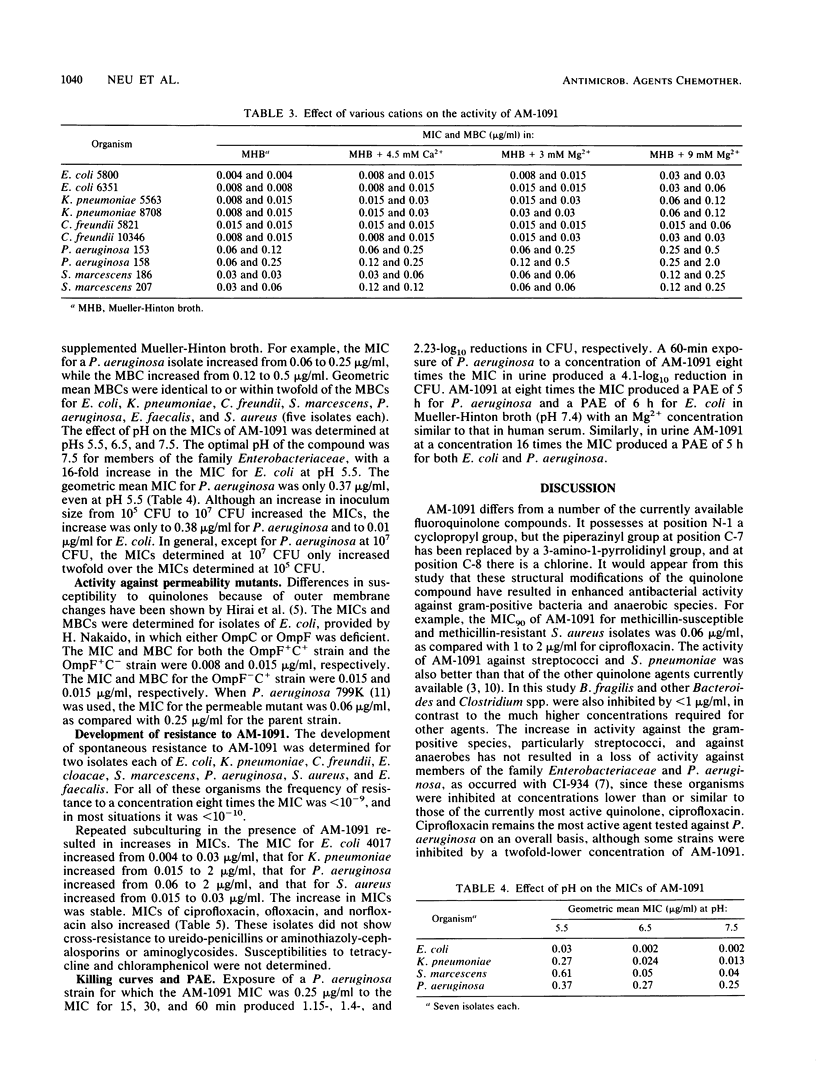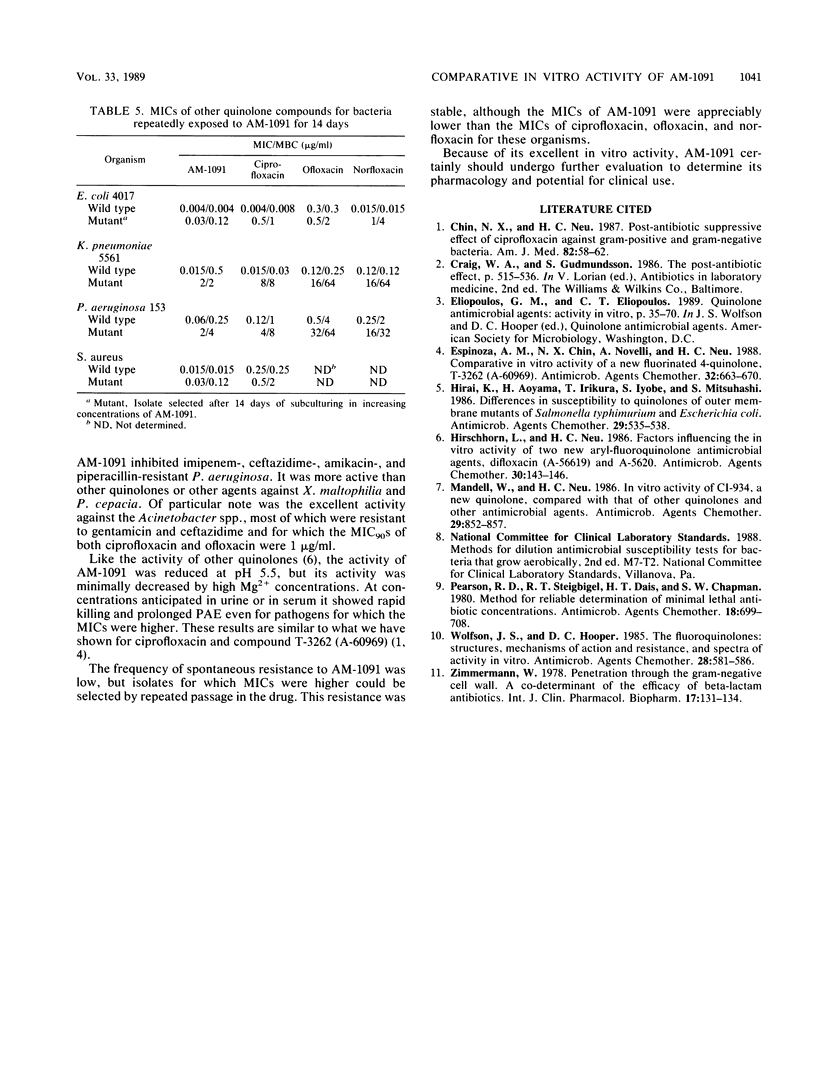Abstract
The in vitro activity of a new quinolone, AM-1091 [7-(3-amino-1-pyrrolidinyl)-8-chloro-1-cyclopropyl-6-fluoro-1,4-dihydro- 4-oxo- 3-quinoline carboxylic acid hydrochloride], was compared with those of ciprofloxacin, ofloxacin, beta-lactams, and gentamicin. AM-1091 inhibited 90% of the isolates of the family Enterobacteriaceae at less than or equal to 0.12 micrograms/ml. For many species AM-1091 was 2-fold more active than ciprofloxacin and 2- to 32-fold more active than ofloxacin. It inhibited Enterobacter, Citrobacter, and Klebsiella species resistant to ceftazidime and gentamicin. Ninety percent of Pseudomonas aeruginosa isolates were inhibited by 0.5 micrograms/ml, so for this species AM-1091 was twofold less active than ciprofloxacin. AM-1091 was more active against Pseudomonas cepacia and Xanthomonas maltophilia, inhibiting isolates resistant to imipenem and gentamicin. Most Haemophilus influenzae, Neisseria gonorrhoeae, Neisseria meningitidis, and Branhamella catarrhalis isolates were inhibited by less than or equal to 0.06 micrograms/ml. The MICs for 90% of Staphylococcus aureus, Staphylococcus epidermidis, and Enterococcus faecalis isolates were 0.06, 0.06, and 2 micrograms/ml, respectively. AM-1091 inhibited hemolytic streptococci and Streptococcus pneumoniae at 0.25 micrograms/ml and was more active than ciprofloxacin or ofloxacin against gram-positive species. AM-1091 inhibited 90% of the Bacteroides species at 0.5 micrograms/ml. The frequency of spontaneous resistance was less than 10(-10) for most organisms, but resistant strains could be selected by repeated subculturing. Although AM-1091 had lower in vitro activity at pH 5.5 and in the presence of high concentrations of Mg2+, it still inhibited most organisms at </= 0.5 micrograms/ml under these conditions. AM-1091 rapidly killed Escherichia coli and P. aeruginosa and had a prolonged postantibiotic suppressive effect on these bacteria.
Full text
PDF





Selected References
These references are in PubMed. This may not be the complete list of references from this article.
- Chin N. X., Neu H. C. Post-antibiotic suppressive effect of ciprofloxacin against gram-positive and gram-negative bacteria. Am J Med. 1987 Apr 27;82(4A):58–62. [PubMed] [Google Scholar]
- Espinoza A. M., Chin N. X., Novelli A., Neu H. C. Comparative in vitro activity of a new fluorinated 4-quinolone, T-3262 (A-60969). Antimicrob Agents Chemother. 1988 May;32(5):663–670. doi: 10.1128/aac.32.5.663. [DOI] [PMC free article] [PubMed] [Google Scholar]
- Hirai K., Aoyama H., Irikura T., Iyobe S., Mitsuhashi S. Differences in susceptibility to quinolones of outer membrane mutants of Salmonella typhimurium and Escherichia coli. Antimicrob Agents Chemother. 1986 Mar;29(3):535–538. doi: 10.1128/aac.29.3.535. [DOI] [PMC free article] [PubMed] [Google Scholar]
- Hirschhorn L., Neu H. C. Factors influencing the in vitro activity of two new aryl-fluoroquinolone antimicrobial agents, difloxacin (A-56619) and A-56620. Antimicrob Agents Chemother. 1986 Jul;30(1):143–146. doi: 10.1128/aac.30.1.143. [DOI] [PMC free article] [PubMed] [Google Scholar]
- Mandell W., Neu H. C. In vitro activity of CI-934, a new quinolone, compared with that of other quinolones and other antimicrobial agents. Antimicrob Agents Chemother. 1986 May;29(5):852–857. doi: 10.1128/aac.29.5.852. [DOI] [PMC free article] [PubMed] [Google Scholar]
- Pearson R. D., Steigbigel R. T., Davis H. T., Chapman S. W. Method of reliable determination of minimal lethal antibiotic concentrations. Antimicrob Agents Chemother. 1980 Nov;18(5):699–708. doi: 10.1128/aac.18.5.699. [DOI] [PMC free article] [PubMed] [Google Scholar]
- Wolfson J. S., Hooper D. C. The fluoroquinolones: structures, mechanisms of action and resistance, and spectra of activity in vitro. Antimicrob Agents Chemother. 1985 Oct;28(4):581–586. doi: 10.1128/aac.28.4.581. [DOI] [PMC free article] [PubMed] [Google Scholar]
- Zimmermann W. Penetration through the gram-negative cell wall: a co-determinant of the efficacy of beta-lactam antibiotics. Int J Clin Pharmacol Biopharm. 1979 Mar;17(3):131–134. [PubMed] [Google Scholar]


